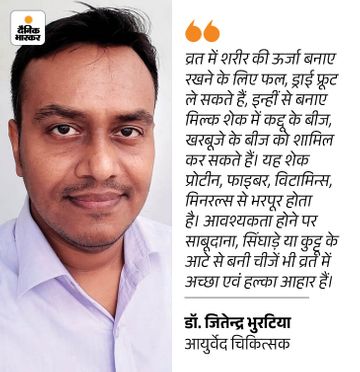Falahar ka “Smosa& Gulabjamun”
Product details
Eat fruit samosa and gulab jamun during fasting: They are prepared from 4 types of flour including water chestnut; the chutney is also special
Devotees eat samosa for breakfast and gulab jamun for dessert
Kota Kachori located on Tonk Road in Jaipur has more than 20 varieties of fruit food available here but many fasting devotees have their breakfast with samosas here.
Kota Kachori's owner Robin Jain said- In 1984, my father Rajendra Kumar Jain started selling fruit food in Kota under the name Jai Jinendra. After this, in 2008, we opened the first outlet named 'Falahaar' in Jaipur. Then in 2012, we started an outlet named Kota Kachori on Tonk Road. Here, he did many experiments to increase the range of fruit food dishes.

Falahari samosa prepared on customer's demand
Jain said- Initially we used to serve Sabudana Khichdi, 10 types of Namkeen, Shrikhand, Fruit Cream, Kalakand and Lassi. Gradually, the customers coming during fasting started demanding some spicy food and fried items. We started experimenting to fulfill the demand of the customers.
First we made Falahari Kachori, but its taste was not right. Then we thought why not prepare Falahari Samosa. The most difficult task was to make the base of the samosa from Falahari items. We tried to make the base from flour prepared by grinding different types of Falahari items. Sometimes the samosa was turning black and sometimes the material was not setting.
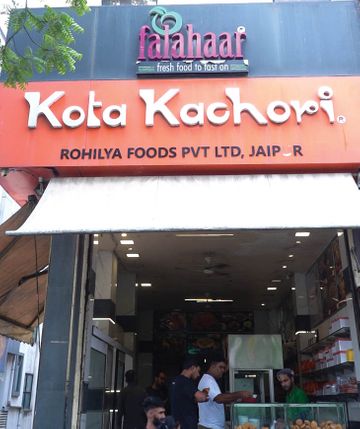
Finally, I prepared a mixture of four types of falahari flour. The quantity of all the ingredients in that mixture was decided according to taste. Then the base of the samosa was made. Banana was used instead of potatoes in the stuffing material.
Robin says that most of our customers are Jains. People of Jain community do not eat potatoes. So we prepared banana masala. Then the samosa that was prepared, people started liking its taste a lot. This samosa has now become a favorite dish of people not only on fasting days but also on normal days.
Two types of chutney are also served with it. This too has been specially prepared for this samosa.

Steps to prepare Falahari Samosa
Samosa base: Samosas are made using four types of vegetarian flours. Sabudana, Rajgir, Singhara and Mordhan. Rock salt is added to all the flours. The base dough is prepared by adding peanut oil for kneading. Now it is kept covered for 15 to 20 minutes so that the dough can set.
Banana stuffing: Bananas are boiled to fill the samosa. Now tempering is done in peanut oil, in which cumin, green chillies, green coriander, fennel are used. White and black pepper, rock salt, cumin powder are added in the spices. Now cashews and raisins are added and stuffed in the samosa.
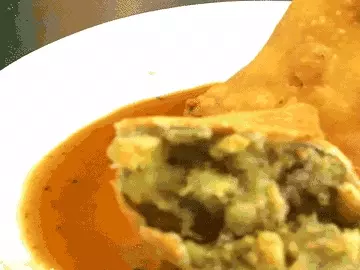
Deep frying: After stuffing, the samosa is kept at a special temperature for some time before frying. Now the samosa is fried in desi ghee or peanut oil.
Two types of chutney: To serve with samosas, prepare sweet dry mango chutney and green coriander chutney. Green coriander chutney is made by mixing coconut and curd, which makes it taste even more delicious.

Falahari Gulab Jamun is special
In Iran, around the 13th century, balls made of flour were fried in ghee and dipped in honey syrup and eaten. When this dish came to India, it came to be known as Gulab Jamun. Robin Jain has also prepared a vegetarian version of Gulab Jamun, one of the most popular dishes of India.
He tells that Gulab Jamun is usually made with mawa and refined flour. But in his place, to make Falahari Gulab Jamun, they mix sago, rajgir, water chestnut and mordhan flour with mawa. No chemical is used in making Falahari Gulab Jamun. Neither baking powder is added. It is baked in Desi Ghee.
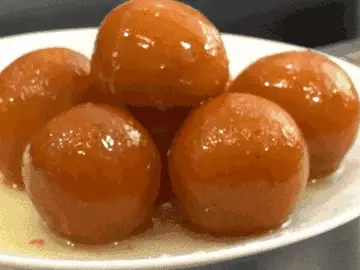
Steps to make Gulab Jamun
- Take fresh khoya (mawa) in a plate. To make Gulab Jamun soft, lightly roast the khoya. Now mix sifted sabudana, rajgir, water chestnut and mordhan flour in it. Mash it well and make it smooth.
- Prepare one string syrup by adding sugar and water in a vessel. Lastly, add cardamom powder and saffron.
- Make small balls from the Gulab Jamun mixture. Fill them with cashews, pistachios, chironji seeds and roll them in a round shape and fry them until they turn golden brown.
- When it turns golden, remove it from the pan and put it in the syrup. Our Gulab Jamuns are ready. These Falahari Gulab Jamuns can be eaten during fasting.
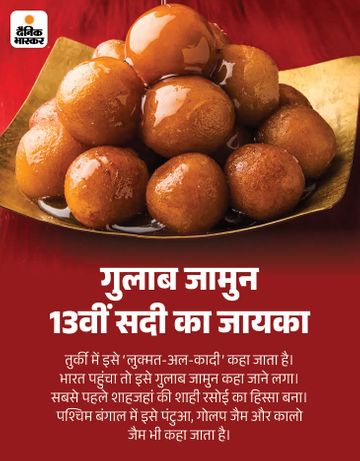
20 types of vegetarian items and snacks
Robin Jain told that they have 20 varieties of food to eat during fasting. Sabudana Khichdi, Sabudana Dahi Bada, Sabudana Bada, Falahari Samosa, Almond Milk, Fruit Cream, Shrikhand, Kalakand, Falahari Gulab Jamun, Makhania Lassi are available.
Apart from this, there are many types of falahari snacks like potato chivda, falahari sabudana, Rajgir sabudana, dry khichdi, charka falahari, almond lachcha, potato stick red, potato wafers, chatora wafers, falahari daana, falahari mathri.
Special tips for fasting
When the body lacks protein, one starts feeling hungry. In such a situation, one can eat rotis made of Rajgira and water chestnut flour and vegetables like spinach, mint and coriander leaves. Up to 40 milligrams of calcium is found in rotis made of Rajgira flour. This will provide nutrients like fiber, anti-oxidants, vitamins and minerals.
This will prevent gas on an empty stomach and sugar and blood pressure patients will continue to get adequate nutrition. Eat food by chewing it well. This will make digestion easier and there will be no acidity.
